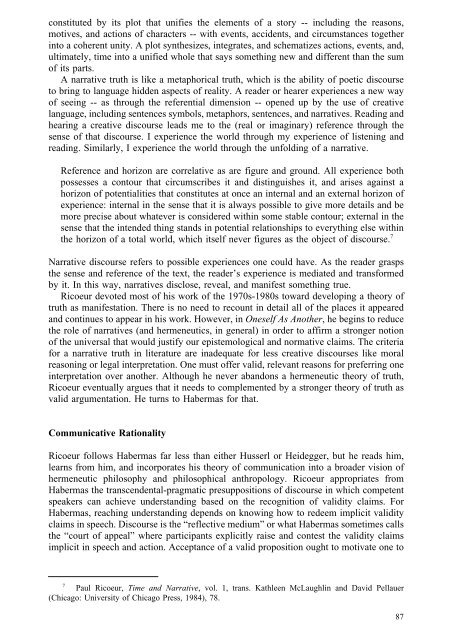[Andrzej_Wiercinski_(ed ... - WordPress.com
[Andrzej_Wiercinski_(ed ... - WordPress.com
[Andrzej_Wiercinski_(ed ... - WordPress.com
You also want an ePaper? Increase the reach of your titles
YUMPU automatically turns print PDFs into web optimized ePapers that Google loves.
constitut<strong>ed</strong> by its plot that unifies the elements of a story -- including the reasons,motives, and actions of characters -- with events, accidents, and circumstances togetherinto a coherent unity. A plot synthesizes, integrates, and schematizes actions, events, and,ultimately, time into a unifi<strong>ed</strong> whole that says something new and different than the sumof its parts.A narrative truth is like a metaphorical truth, which is the ability of poetic discourseto bring to language hidden aspects of reality. A reader or hearer experiences a new wayof seeing -- as through the referential dimension -- open<strong>ed</strong> up by the use of creativelanguage, including sentences symbols, metaphors, sentences, and narratives. Reading andhearing a creative discourse leads me to the (real or imaginary) reference through thesense of that discourse. I experience the world through my experience of listening andreading. Similarly, I experience the world through the unfolding of a narrative.Reference and horizon are correlative as are figure and ground. All experience bothpossesses a contour that circumscribes it and distinguishes it, and arises against ahorizon of potentialities that constitutes at once an internal and an external horizon ofexperience: internal in the sense that it is always possible to give more details and bemore precise about whatever is consider<strong>ed</strong> within some stable contour; external in thesense that the intend<strong>ed</strong> thing stands in potential relationships to everything else withinthe horizon of a total world, which itself never figures as the object of discourse. 7Narrative discourse refers to possible experiences one could have. As the reader graspsthe sense and reference of the text, the reader’s experience is m<strong>ed</strong>iat<strong>ed</strong> and transform<strong>ed</strong>by it. In this way, narratives disclose, reveal, and manifest something true.Ricoeur devot<strong>ed</strong> most of his work of the 1970s-1980s toward developing a theory oftruth as manifestation. There is no ne<strong>ed</strong> to recount in detail all of the places it appear<strong>ed</strong>and continues to appear in his work. However, in Oneself As Another, he begins to r<strong>ed</strong>ucethe role of narratives (and hermeneutics, in general) in order to affirm a stronger notionof the universal that would justify our epistemological and normative claims. The criteriafor a narrative truth in literature are inadequate for less creative discourses like moralreasoning or legal interpretation. One must offer valid, relevant reasons for preferring oneinterpretation over another. Although he never abandons a hermeneutic theory of truth,Ricoeur eventually argues that it ne<strong>ed</strong>s to <strong>com</strong>plement<strong>ed</strong> by a stronger theory of truth asvalid argumentation. He turns to Habermas for that.Communicative RationalityRicoeur follows Habermas far less than either Husserl or Heidegger, but he reads him,learns from him, and incorporates his theory of <strong>com</strong>munication into a broader vision ofhermeneutic philosophy and philosophical anthropology. Ricoeur appropriates fromHabermas the transcendental-pragmatic presuppositions of discourse in which <strong>com</strong>petentspeakers can achieve understanding bas<strong>ed</strong> on the recognition of validity claims. ForHabermas, reaching understanding depends on knowing how to r<strong>ed</strong>eem implicit validityclaims in speech. Discourse is the “reflective m<strong>ed</strong>ium” or what Habermas sometimes callsthe “court of appeal” where participants explicitly raise and contest the validity claimsimplicit in speech and action. Acceptance of a valid proposition ought to motivate one to7Paul Ricoeur, Time and Narrative, vol. 1, trans. Kathleen McLaughlin and David Pellauer(Chicago: University of Chicago Press, 1984), 78.87


